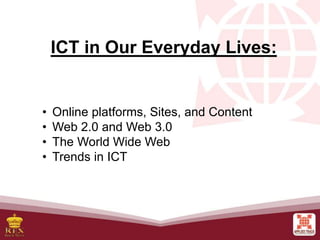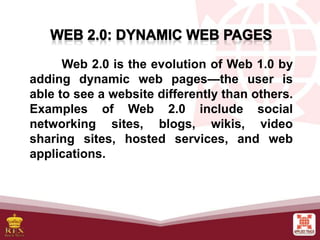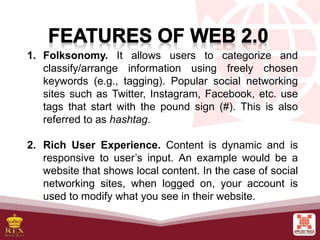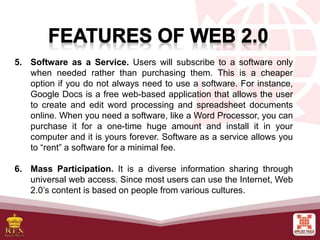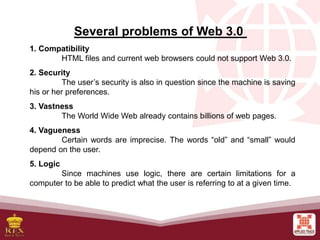L1 Introduction to Information and Communication Technology.pptx
- 1. ICT in Our Everyday Lives: • Online platforms, Sites, and Content • Web 2.0 and Web 3.0 • The World Wide Web • Trends in ICT
- 2. Introduction to Information and Communication Technologies • The state of ICT technologies • Online systems, functions, and platforms
- 3. At the end of this lesson, the students should be able to: 1. improve their knowledge on how ICT affects their everyday lives and the state of our nation; 2. compare and contrast the differences between online platforms, sites, and content; 3. understand the features of Web 2.0; 4. understand the future of the World Wide Web through Web 3.0; and 5. learn the different trends in ICT and use them to their advantage.
- 4. Information and Communication Technologies Information and Communication Technology (ICT) deals with the use of different communication technologies such as mobile phones, telephone, Internet, etc. to locate, save, send and edit information.
- 5. How important is ICT to your daily activities?
- 6. How ICT affected the Philippines in different aspects of living (e.g., economic, social, etc.).
- 7. When the World Wide Web was invented, most web pages were static. Static (also known as flat page or stationary page) in the sense that the page is “as is” and cannot be manipulated by the user. The content is also the same for all users. This is referred to as Web 1.0.
- 8. Web 2.0 is the evolution of Web 1.0 by adding dynamic web pages—the user is able to see a website differently than others. Examples of Web 2.0 include social networking sites, blogs, wikis, video sharing sites, hosted services, and web applications.
- 9. Web 2.0 allows users to interact with the page: instead of just reading a page, the user may be able to comment or create a user account. Web 2.0 also allows users to use web browsers instead of just using their operating system. Browsers can now be used for their user interface, application software (or web applications), and even for file storage.
- 10. Most websites that we visit today are Web 2.0.
- 11. 1. Folksonomy. It allows users to categorize and classify/arrange information using freely chosen keywords (e.g., tagging). Popular social networking sites such as Twitter, Instagram, Facebook, etc. use tags that start with the pound sign (#). This is also referred to as hashtag. 2. Rich User Experience. Content is dynamic and is responsive to user’s input. An example would be a website that shows local content. In the case of social networking sites, when logged on, your account is used to modify what you see in their website.
- 12. 3. Long Tail. Services are offered on demand rather than on a one- time purchase. In certain cases, time-based pricing is better than file-size-based pricing or vice versa. This is synonymous to subscribing to a data plan that charges you for the amount of time you spent in the Internet, or a data plan that charges you for the amount of bandwidth you used. 4. User Participation. The owner of the website is not the only one who is able to put content. Others are able to place a content of their own by means of comment, reviews, and evaluation. Some websites allow readers to comment on an article, participate in a poll, or review a specific product (e.g., Amazon.com, online stores).
- 13. 5. Software as a Service. Users will subscribe to a software only when needed rather than purchasing them. This is a cheaper option if you do not always need to use a software. For instance, Google Docs is a free web-based application that allows the user to create and edit word processing and spreadsheet documents online. When you need a software, like a Word Processor, you can purchase it for a one-time huge amount and install it in your computer and it is yours forever. Software as a service allows you to “rent” a software for a minimal fee. 6. Mass Participation. It is a diverse information sharing through universal web access. Since most users can use the Internet, Web 2.0’s content is based on people from various cultures.
- 14. The Semantic Web is a movement led by the World Wide Web Consortium (W3C). The W3C standard encourages web developers to include semantic content in their web pages.
- 15. According to the W3C, “The Semantic Web provides a common framework that allows data to be shared and reused across application, enterprise, and community boundaries.” The aim of Web 3.0 is to have machines (or servers) understand the user’s preferences to be able to deliver web content specifically targeting the user.
- 16. Several problems of Web 3.0 1. Compatibility HTML files and current web browsers could not support Web 3.0. 2. Security The user’s security is also in question since the machine is saving his or her preferences. 3. Vastness The World Wide Web already contains billions of web pages. 4. Vagueness Certain words are imprecise. The words “old” and “small” would depend on the user. 5. Logic Since machines use logic, there are certain limitations for a computer to be able to predict what the user is referring to at a given time.
- 17. 1. Convergence Technological convergence is the synergy of technological advancements to work on a similar goal or task. 2. Social Media Social media is a website, application, or online channels that enable web users to create, co- create, discuss, modify, and exchange user- generated content.
- 18. a. Social Networks. These are sites that allow you to connect with other people with the same interests or background. b. Bookmarking Sites. These are sites that allow you to store and manage links to various websites and resources. c. Social News. These are sites that allow users to post their own news items or links to other news sources. d. Media Sharing. These are sites that allow you to upload and share media content like images, music, and video. e. Microblogging. These are sites that focus on short updates from the user. f. Blogs and Forums. These websites allow users to post their content.
- 19. 3. Mobile Technologies The popularity of smartphones and tablets has taken a major rise over the years. This is largely because of the devices’ capability to do tasks that were originally found in personal computers. a. iOS b. Android c. Blackberry OS d. Windows Phone OS e. Symbian f. WebOS g. Windows Mobile
- 20. 4. Assistive Media Assistive media is a nonprofit service designed to help people who have visual and reading impairments. A database of audio recordings is used to read to the user.

